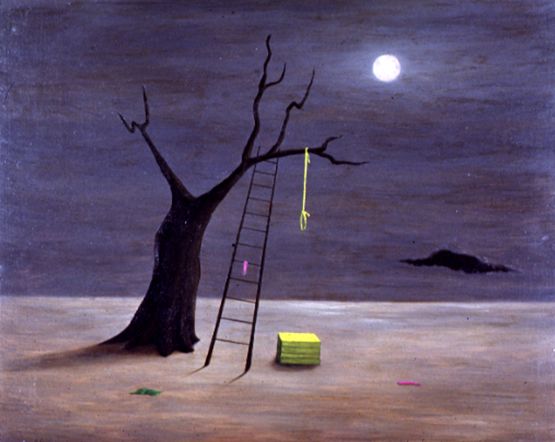Gertrude Abercrombie (Texas 1909 – Illinois 1977)
Get a Gertrude Abercrombie (Texas 1909 – Illinois 1977) Certificate of Authenticity for your painting (COA) for your Gertrude Abercrombie (Texas 1909 – Illinois 1977) drawing.
For all your Gertrude Abercrombie (Texas 1909 – Illinois 1977) artworks you need a Certificate of Authenticity (COA) in order to sell, to insure or to donate for a tax deduction.
Getting a Gertrude Abercrombie (Texas 1909 – Illinois 1977) Certificate of Authenticity (COA) is easy. Just send us photos and dimensions and tell us what you know about the origin or history of your Gertrude Abercrombie (Texas 1909 – Illinois 1977) painting or drawing.
If you want to sell your Gertrude Abercrombie (Texas 1909 – Illinois 1977) painting or drawing use our selling services. We offer Gertrude Abercrombie (Texas 1909 – Illinois 1977) selling help, selling advice, private treaty sales and full brokerage.
We have been authenticating Gertrude Abercrombie (Texas 1909 – Illinois 1977) and issuing certificates of authenticity since 2002. We are recognized Gertrude Abercrombie (Texas 1909 – Illinois 1977) experts and Gertrude Abercrombie (Texas 1909 – Illinois 1977) certified appraisers. We issue COAs and appraisals for all Gertrude Abercrombie (Texas 1909 – Illinois 1977) artworks.
Our Gertrude Abercrombie (Texas 1909 – Illinois 1977) paintings and drawings authentications are accepted and respected worldwide.
Each COA is backed by in-depth research and analysis authentication reports.
The Gertrude Abercrombie (Texas 1909 – Illinois 1977) certificates of authenticity we issue are based on solid, reliable and fully referenced art investigations, authentication research, analytical work and forensic studies.
We are available to examine your Gertrude Abercrombie (Texas 1909 – Illinois 1977) painting or drawing anywhere in the world.
You will generally receive your certificates of authenticity and authentication report within two weeks. Some complicated cases with difficult to research Gertrude Abercrombie (Texas 1909 – Illinois 1977) paintings or drawings take longer.
Our clients include Gertrude Abercrombie (Texas 1909 – Illinois 1977) collectors, investors, tax authorities, insurance adjusters, appraisers, valuers, auctioneers, Federal agencies and many law firms.
We perform Gertrude Abercrombie art authentication, appraisal, certificates of authenticity (COA), analysis, research, scientific tests, full art authentications. We will help you sell your Gertrude Abercrombie or we will sell it for you.
The only child of a couple, who were principals in a touring opera company, Gertrude Abercrombie was born in Austin, Texas but grew up in Berlin, Germany. She was fluent in German. With the advent of World War I, she and her family moved back to the United States, this time to western Illinois. Shortly afterward, her mother became ill and was no longer able to sing. Her family moved to the Hyde Park section of Chicago, near the Art Institute and the University of Chicago.
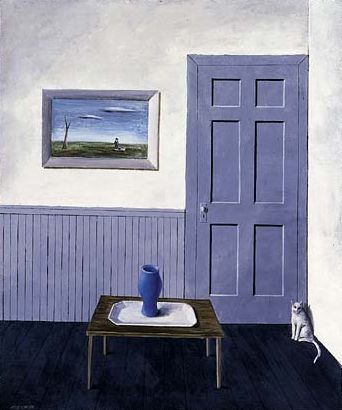
Abercrombie studied languages at University of Illinois Champaign-Urbana. After getting her bachelor’s degree, she studied painting at the American Academy of Art and the Art Institute both in Chicago. She did illustrations for the Sears Roebuck catalogue.
During the Great Depression, she worked for the U.S. Works Progress Administration (WPA) and the federal Public Works of Art Project. She met fiction writer James Purdy through the WPA, and he immortalized Abercrombie as a character in several of his novels.
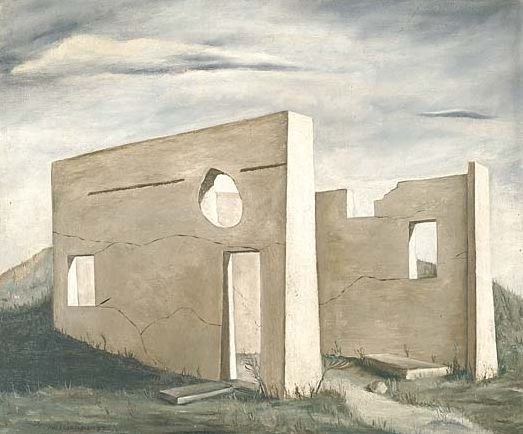
Abercrombie married in 1940 and had her only child in 1944. She moved to the house in which she would live for the rest of her life, until her death at age sixty-eight in 1977.
The composition here shows the increasing influence of Abstraction and Expressionism on Abercrombie’s work. The exaggerated cold, dead eyes, with massive dark circles and puffiness, and the deathly pallor show Abercrombie’s pessimism. The woman’s posture is so stiff as to be nearly dead. The shoulders and arms are dispropritiatately large compared with the head. The hair is carelessly styled, beauty is an afterthought to survival. The background is similar to the walls of Abercrombie’s own home, which were in avant-garde style, painted gray.
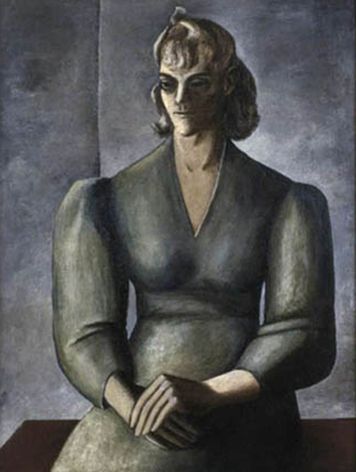
During the 1940s, Abercromie produced over sixty paintings. Her themes became more spiritual during the late 1940s and early 1950s. Abercrombie had her first solo exhibit in 1944 at the Art Institute of Chicago. She had nineteen solo exhibits during her life, mostly in Chicago and major cities of the mid-west. In 1946, Abercrombie was awarded the William and Bertha Clusmann Prize of the Art Institute, Chicago.
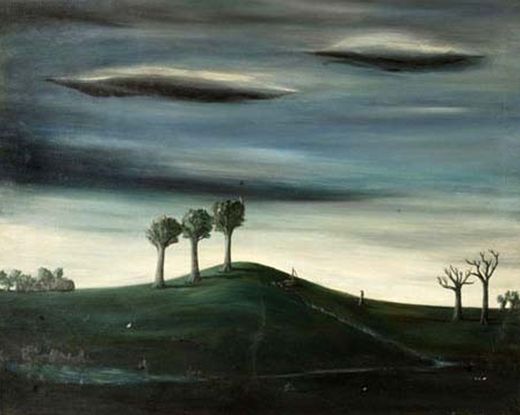
Like many artists of the 1940s and 1950s, Abercrombie was appalled by the violent racism of America. Jazz musician Dizzy Gillespie said Abercrombie was “the bop artist who has taken the essence of our music and transported it to another art form.” Her painting about Chicago musician Charlie Parker’s lynching (below) is haunting for its lack of human presence. It is nearly minimalist, with the perfectly circular white moon shining through the stark outline of tree and ladder. The mixture of dark colors in the sky tell a tale of sadness and resignation.
